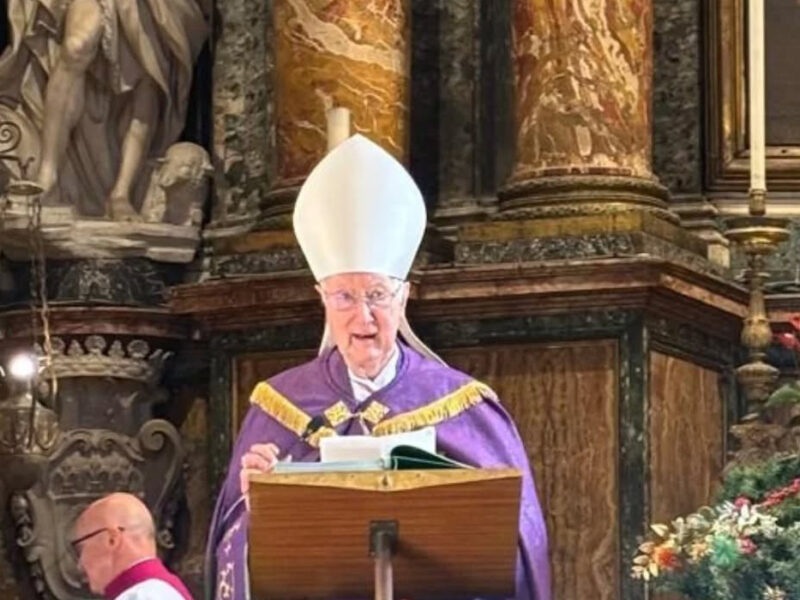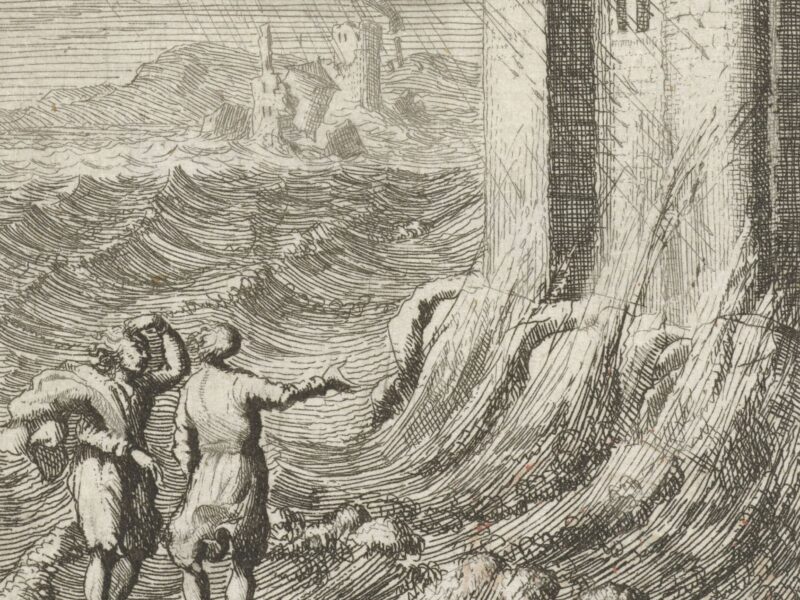
Disciples in the Dark, Part I
As we approach the end of Eastertide, Br Augustine uses the imagery of this year’s Paschal candle to ponder the Church’s journey from the flame of Easter night to the fire of Pentecost.

Easter is a season bookended by light. It begins in the dark of night, and is proclaimed by the ringing voice of the Church as she bears aloft a tall candle, a ‘pillar of fire by night’ (Ex 13:21). It ends on the day of Pentecost, with the Holy Spirit descending on the nascent Church as tongues of fire, diverse yet undivided. ‘In my beginning is my end,’ says the poet, and at the very start of Eastertide we glimpse its culminating-point: as we receive the flame from the one Paschal candle to renew our baptismal promises on Easter night, we are reminded of our Pentecost vocation to ‘go out into the whole world’ and ‘proclaim the good news’. Lo! our Sun’s eclipse is o’er, and ‘to the furthest end of the sky is his course’, for his Name will be proclaimed ‘unto the utmost bounds of the world’ (Ps 19:6,4). In his Passion, we witnessed the outpouring of his love; in the fanning-forth of the Paschal flame, we bear witness to this, to what he has done for us, for from the Lord’s pierced side issues the fount of living water that is the spring of the Christian faith. And in his pierced side, we find a prefiguration of Pentecost: ‘The Son’s Cross is the revelation of the Father’s love (Rom 8:32, Jn 3:16), and the bloody outpouring of that love comes to its inner fulfilment in the shedding abroad of their common Spirit into the hearts of men (Rom 5:5)’ (von Balthasar). May the flame the Spirit has kindled in us ‘be found still burning by the morning-star, the One morning-star who never sets’ (Exsultet), Jesus Christ, when he comes again.

The Cross here is black and white, the colours adorning the cross on the Dominican crest. The black and white evoke the chiaroscuro – the creative tension between light and darkness that clarifies our sight and insight – of Easter night, that night brighter than the dawn, when we sit in the church in darkness as we await in joyful hope the news announced by Mary Magdalene to the Apostles. Like the Paschal candle, the Cross is shrouded, for on it, God reveals himself as the Mystery hidden from before the ages and now made known to us precisely as the mystery of divine love. Yet the shadow cast by the Cross is light – both a negative and a positive light, so to speak – it negates our sins, the shackles of our passions, the waywardness of our illusions; it heals, restores and strengthens. And Christ presents us with the Cross as a via negativa, a road of self-negation and humility, a means of instruction into the light and life of God. ‘Do not seek Christ without the Cross,’ reminds St John of the Cross. The suffering of the Cross cannot be viewed in abstraction from the sublime realities it promises: the Paschal mystery plants our feet firmly on the rock of faith, not for us to stand still, but to walk the way of the Cross to our Resurrection.
The pinnacle of history is the event of Christ’s incarnate life, for Christ is Alpha and Omega, the beginning and the end. Through the sacrifice of Christ, Love’s redeeming work is done, and the Cross is become the tree of life for us. Adorned with the crimson letters AO, and the crimson numbers 2023, the Cross shines forth as the ‘true pole of the nations’, the axis on which the world turns, clutched by the One in whom ‘there is no variableness nor shadow of turning’ (Ps 48:2; Jas 1:17). The red AO represent the Blood of Christ poured out into history, and the red numbers of the year the blood of the martyrs shed throughout our present age, the Apostolic Age, inaugurated at Pentecost following the very first Eastertide. It is they who kindled the living flame of love amid the fires of persecution, exile and oppression, they who conquered the devil ‘by the Blood of the Lamb and the word of their witness, for they loved not their lives even unto death’ (Apoc 12:11). They testify to the fact that one can only follow Christ if one is strengthened by the Spirit, for no one can confess that Jesus is Lord but by the Spirit (1 Cor 12:3). The Spirit empowers us to imitate the pioneer and perfecter of our faith, who has given us an example, that we might follow in his steps (Heb 12:2, 1 Pet 2:21). Now let us consider the Lord:

In this image, Christ is poised for action, It is God who has set the stage for the divine drama of redemption. Christ turns his Passion into action by obediently submitting to the Father’s will. Yes, he lays down his life, but he does so precisely to take it up again. Laying down his life, he lays it down for us as gift and example; taking it up again, he takes us up into himself. For this reason, his arm is outstretched to the Cross, to gather all nations unto himself, so that ‘from the rising of the sun to its setting, a pure sacrifice may be offered’ to God’s Name (Mal 1:11). Christ has his ‘arm outstretched, with power in his hand, for his great love has no end (Ps 136:12).’ And in the Crucified and Risen Christ, God has ‘shown the strength of his arm’ (Lk 1:51).
It is with this light of revelation that the figure of Christ shines. The raiments of Christ’s Resurrection are a blend of three hues, in proportions varying for each garment: vermillion, the colour of the rays of the rising Sun, for Christ is the Sun who has risen to set no more; yellow ochre, the colour of eternity outside time, to represent the irruption of eternity into the temporal by his ‘resurrection into definitive otherness in the midst of the continuing old world’ (Ratzinger); orange, a colour synonymous with a fruit, for the Risen Christ is the ‘first-fruits of all who have fallen asleep’. A fruit must die for its seeds to fan forth through all the earth. In Christ’s death, God has ‘fashioned a remedy out of mortality itself, so that the cause of our downfall might become the means of our salvation’ (Preface III of the Sundays in Ordinary Time). On the Tree of Life, the fruit of Mary’s womb reaches his full flowering, refulgent in glory, and his Resurrection is a pledge of ours, bearing fruit in us by our baptism, our dying and rising with him. Fittingly does Isaiah call him Father of the world to come (9:6).
The candle is borne upon a pedestal: the light of the mystery of God rests above common comprehension. On Easter night, the darkness looms and beckons, almost enshrouding the candle, but not quite. The darkness has been defeated – the flame shows it for what it is, merely the absence of light. One small flame vanquishes the pervasive reign of gloom; one shepherd-boy vanquishes the giant-champion of the Philistines; one man dies to vanquish the sins of a whole nation and the whole world. The mystery manifested on Easter night is that this man is God, the death of death and the life who is the light of all (Jn 1:4). The darkness is transfigured. No longer is it a darkness of unbelief, but of unknowing, of wonder before the mystery of a love that surpasses all understanding. Ours is to be ‘disciples in the dark’ (Robert Ombres OP), to follow the Risen Lord in the darkness of faith, the receptacle of the divine life. The candle is a pillar pointing to Pentecost, telling of these mysteries even when the Lord has been taken from our sight, reminding us to enliven our desire for the Spirit who will bring God’s work in us to completion. Holding on to hope, we walk with God in the pitch-black of his presence, for by the Spirit we have come to know and believe that God is with us, and for him, even ‘the night is as bright as the day’ (Ps 139:12). God ‘will give light to those in darkness, to those who dwell in the shadow of death; he will guide our feet in the way of peace’ (Lk 1:79). He will send his Spirit to abide with us forever (Jn 14:15-17). Alleluia.


